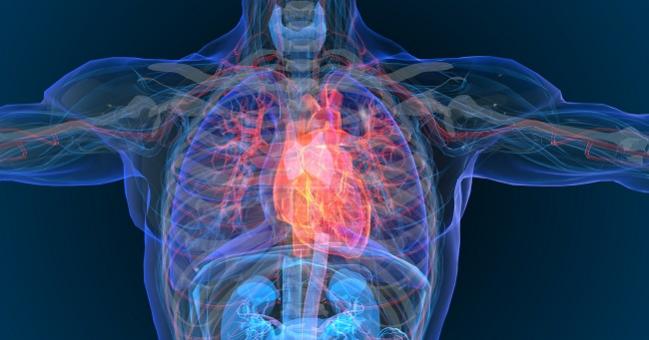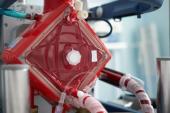LAVA ECMO: Early Data Point to Hemodynamic Benefits, Safety
For patients with biventricular failure in cardiogenic shock, the single-cannula method offers LV unloading.

Use of left atrial venoarterial cannulation during extracorporeal membrane oxygenation—a technique known as LAVA ECMO—appears to be a safe and feasible means of support for patients with cardiogenic shock complicated by biventricular failure, early data suggest.
Today in a late-breaking session at the Technology and Heart Failure Therapeutics (THT) 2022 meeting in New York, Waleed Al-Darzi, MBBCh (Henry Ford Hospital, Detroit MI), presented a retrospective analysis of hemodynamic changes and in-hospital outcomes for 25 consecutive patients treated at his center between July 2020 and January 2022.
Conventional venoarterial (VA) ECMO “is commonly used in patients presenting with biventricular failure with cardiogenic shock as a bridge to myocardial recovery, durable left ventricular assist device, or cardiac transplantation,” Al-Darzi told THT attendees.
But retrograde flow from VA ECMO can result in increased afterload, which may lead to LV distension, LV wall stress, and pulmonary edema, as well as higher myocardial oxygen demand, he explained. Typically, impaired LV unloading in the context of VA ECMO is addressed by adding an intra-aortic balloon pump (IABP) or Impella (Abiomed).
LAVA ECMO, Al-Darzi told TCTMD, has advantages over these existing alternatives. The technique involves echo-guided transseptal entry into the left atrium, insertion of a stiff wire into the pulmonary vein or left atrium, followed by balloon dilatation of the septum as needed, and then over-the-wire implantation of a single 24-Fr venous cannula (VFEM024; Edwards Lifesciences) with a long fenestrated segment (15 cm).
“It’s a great tool in experienced hands,” he said. “What it does is it unloads, or vents, both sides—the right and left side—of the heart at the same time with a single cannula, rather than requiring an additional large-bore arterial access on top of the regular VA ECMO configuration,” as would happen if IABP or Impella were added to help unload the LV.
“Patient selection is important with this configuration . . . . We mostly have been using it in patients with severe valvular heart disease, like severe aortic insufficiency or primary severe mitral regurgitation,” he added. To do the procedure properly requires expertise in transseptal puncture as well as transesophageal or intracardiac echocardiography.
Al-Darzi stressed that the new report is a small, single-center study that didn’t compare directly between LAVA ECMO and other forms of support. What’s noteworthy here, he said, are the positive cardiopulmonary hemodynamic changes.
It’s a great tool in experienced hands. Waleed Al-Darzi
Among the 25 patients, 80% were men, the mean age was 63.6 years, and mean body mass index was 32 kg/m2. The most common comorbidities were hypertension (64%) and diabetes mellitus (36%). By SCAI SHOCK category, 52% were stage D and 16% were stage E, while 4% and 28% were classified as stages B and C, respectively.
Mean LVEF was 36% at baseline. Fully 68% of patients had RV dysfunction, with a mean RV systolic pressure of 53 mm Hg. Valve disease was common: aortic, mitral, and tricuspid regurgitation were seen in 32%, 28%, and 24% of patients. One-quarter had severe aortic stenosis, and 4% had severe mitral stenosis.
Several hemodynamic measures improved after initiation of LAVA ECMO.
Hemodynamic Changes With LAVA ECMO
|
|
Before Implantation |
After Implantation |
P Value |
|
Mean Right Atrial Pressure, mm Hg |
19.75 |
9.08 |
< 0.001 |
|
Mean Pulmonary Arterial Pressure, mm Hg |
41.0 |
26.4 |
< 0.001 |
|
Mean Systemic Arterial Pressure, mm Hg |
79.69 |
79.53 |
0.96 |
|
Heart Rate, bpm |
101.7 |
89.1 |
0.04 |
|
Cardiac Index, L/min/m2 |
1.9 |
4.1 |
< 0.001 |
|
Cardiac Power Output, W |
0.6 |
1.4 |
< 0.001 |
|
Pulmonary Artery Pulsatility Index |
1.67 |
2.56 |
0.0 |
On average, patients spent about a week on LAVA ECMO (mean 7.25 days). Ipsilateral reperfusion sheaths and intracardiac echo each were used in 88% of cases. Only 8% involved additional forms of LV unloading, and 80% were ultimately decannulated. Most patients went on to receive a valve replacement (44%), 12% had a heart transplant, 8% received a durable left ventricular assist device, 4% underwent CABG surgery, and 4% had ventricular septal defect surgical repair. For 16%, the LAVA ECMO was a “bridge to decision.” Three patients, for a rate of 12%, died while on ECMO.
Additionally, in a subset of patients with available measurements for left atrial pressure and LV end-diastolic pressure, mean values for both decreased significantly after implantation, Al-Darzi reported.
In-hospital complications included non-access-site bleeding (28%), infection (28%), new renal replacement therapy (20%), access-site hematoma (12%), stroke (12%), limb ischemia (8%), and hemolysis (4%).
Thirteen patients survived to discharge, amounting to a mortality rate of 48%.
Al-Darzi highlighted a subset of three patients who, due to comorbid PAD or small vessel size, required transcaval access. All, he said, had successful LAVA ECMO as a bridge to valve intervention, and none experienced vascular complications or transcaval bleeding.
Prospective studies are needed, Al-Darzi urged, though he told TCTMD that there’s nothing immediate on the horizon. Up next would be a retrospective comparison between LAVA ECMO and its alternatives, he said.
A ‘Clever’ Take on ECMO
Peter Eckman, MD (Minneapolis Heart Institute, MN), commenting on the findings, told TCTMD that LAVA ECMO does hold appeal. “It’s a single catheter that is both draining the blood to supply the [oxygenator] and at the same time is unloading the left atrium, and so by extension you would expect is unloading the left ventricle,” he explained. “So I think it’s a clever approach that has the potential to be more effective than using a balloon pump or using dobutamine, or [turning] the ECMO down so that you’re not causing so much afterload.” Moreover, he noted, it avoids the cost of implanting an additional device.
Eckman observed that this data set captures a “relatively typical population with severe cardiogenic shock,” though most were men and nearly a third were, as SCAI stage B and C, relatively early in the course of the condition. “It’s not wrong. It’s an aggressive approach, and there may be things we don’t know about why they’re putting it on a stage C patient,” he commented.
And while it would be good to see how LAVA ECMO stacks up against other approaches, the current study is more “proof of concept,” said Eckman, adding, “I think it’s fair to say that this data shows real-world evidence that it looks like [LAVA ECMO is] doing what it’s supposed to do.”
Nir Uriel, MD (NewYork-Presbyterian/Columbia University Irving Medical Center, NY), a panelist during the THT session, said “the concept here is very interesting.”
“We all love to use ECMO, but we are all challenged by the afterload increase,” he commented, noting that in this series, only two out of 25 patients required additional LV unloading. “Right now, almost every ECMO that [we implant], we’ll put a balloon pump or Impella together with it.”
Moderator Gregg Stone, MD (Icahn School of Medicine at Mount Sinai, New York, NY), was similarly positive, calling it a “very clever and very direct device to achieve left heart unloading.”
Note: A prior version of this story misidentified Uriel as panelist Paolo Colombo, MD.
Caitlin E. Cox is News Editor of TCTMD and Associate Director, Editorial Content at the Cardiovascular Research Foundation. She produces the…
Read Full BioSources
Al-Darzi W. Utilization of left-atrial venous arterial extracorporeal membrane oxygenation for biventricular failure in cardiogenic shock. Presented at: THT 2022. New York, NY. February 2, 2022.
Disclosures
- Al-Darzi and Eckman report no relevant conflicts of interest.





Comments